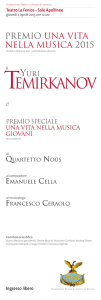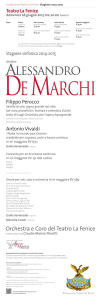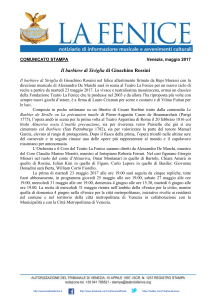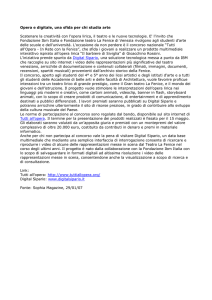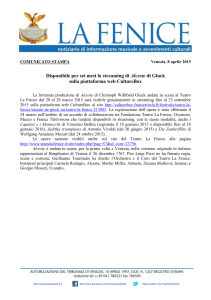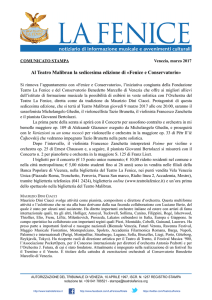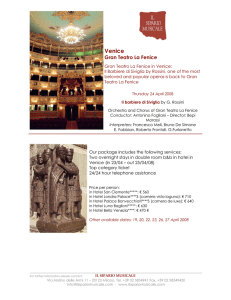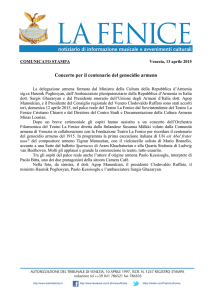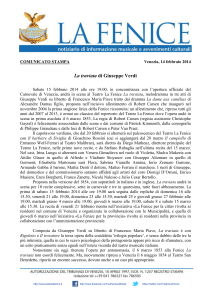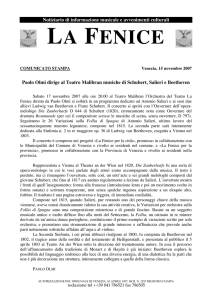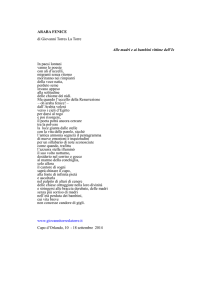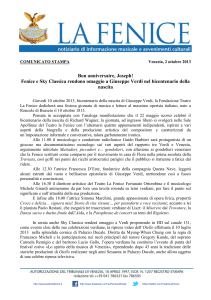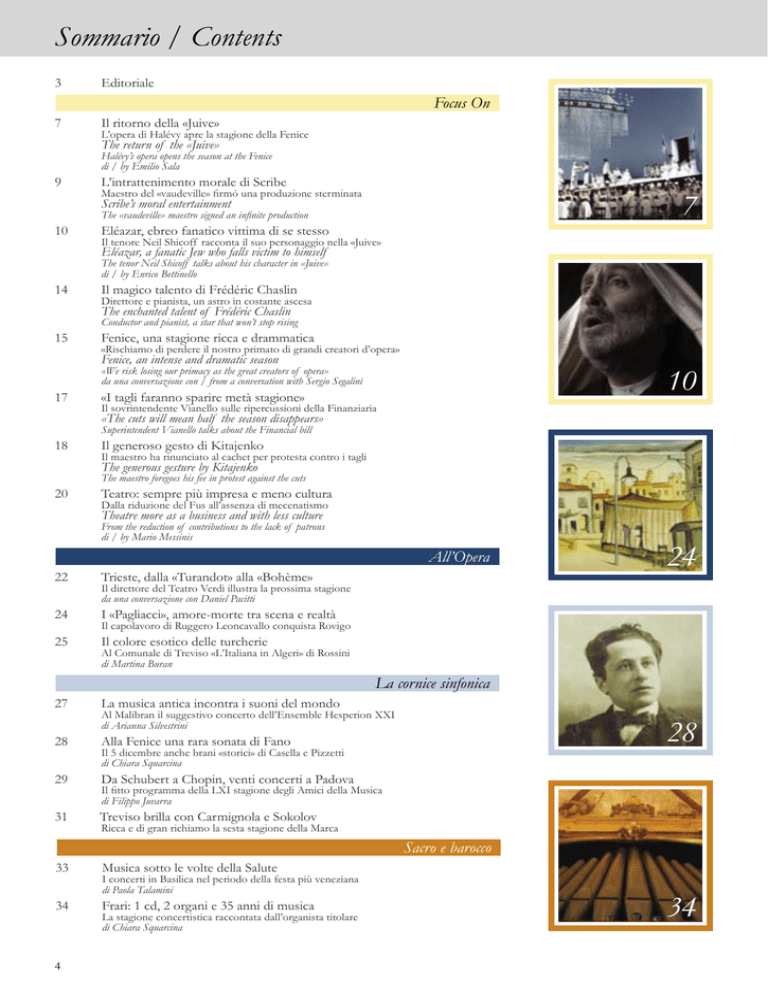
Sommario / Contents
3
Editoriale
Focus On
7
Il ritorno della «Juive»
L’opera di Halévy apre la stagione della Fenice
The return of the «Juive»
Halévy’s opera opens the season at the Fenice
di / by Emilio Sala
9
L’intrattenimento morale di Scribe
7
Maestro del «vaudeville» firmò una produzione sterminata
Scribe’s moral entertainment
The «vaudeville» maestro signed an infinite production
10
Eléazar, ebreo fanatico vittima di se stesso
Il tenore Neil Shicoff racconta il suo personaggio nella «Juive»
Eléazar, a fanatic Jew who falls victim to himself
The tenor Neil Shicoff talks about his character in «Juive»
di / by Enrico Bettinello
14
Il magico talento di Frédéric Chaslin
Direttore e pianista, un astro in costante ascesa
The enchanted talent of Frédéric Chaslin
Conductor and pianist, a star that won’t stop rising
15
Fenice, una stagione ricca e drammatica
«Rischiamo di perdere il nostro primato di grandi creatori d’opera»
Fenice, an intense and dramatic season
10
«We risk losing our primacy as the great creators of opera»
da una conversazione con / from a conversation with Sergio Segalini
17
«I tagli faranno sparire metà stagione»
Il sovrintendente Vianello sulle ripercussioni della Finanziaria
«The cuts will mean half the season disappears»
Superintendent Vianello talks about the Financial bill
18
Il generoso gesto di Kitajenko
Il maestro ha rinunciato al cachet per protesta contro i tagli
The generous gesture by Kitajenko
The maestro foregoes his fee in protest against the cuts
20
Teatro: sempre più impresa e meno cultura
Dalla riduzione del Fus all’assenza di mecenatismo
Theatre more as a business and with less culture
From the reduction of contributions to the lack of patrons
di / by Mario Messinis
All’Opera
22
Trieste, dalla «Turandot» alla «Bohème»
24
I «Pagliacci», amore-morte tra scena e realtà
25
Il colore esotico delle turcherie
24
Il direttore del Teatro Verdi illustra la prossima stagione
da una conversazione con Daniel Pacitti
Il capolavoro di Ruggero Leoncavallo conquista Rovigo
Al Comunale di Treviso «L’Italiana in Algeri» di Rossini
di Martina Buran
La cornice sinfonica
27
La musica antica incontra i suoni del mondo
28
Alla Fenice una rara sonata di Fano
29
Da Schubert a Chopin, venti concerti a Padova
31
Treviso brilla con Carmignola e Sokolov
Al Malibran il suggestivo concerto dell’Ensemble Hesperion XXI
di Arianna Silvestrini
28
Il 5 dicembre anche brani «storici» di Casella e Pizzetti
di Chiara Squarcina
Il fitto programma della LXI stagione degli Amici della Musica
di Filippo Juvarra
Ricca e di gran richiamo la sesta stagione della Marca
Sacro e barocco
33
Musica sotto le volte della Salute
34
Frari: 1 cd, 2 organi e 35 anni di musica
4
I concerti in Basilica nel periodo della festa più veneziana
di Paola Talamini
La stagione concertistica raccontata dall’organista titolare
di Chiara Squarcina
34
Sommario / Contents
Note veneziane
38
L’Ateneo Veneto ha aperto le porte alla musica
39
Una Fenice per Uto Ughi e l’Airc
40
Rubelli «veste» la Fenice per i suoi cinquant’anni di attività
Cento eventi in quattro anni voluti dal presidente Alfredo Bianchini
Mondanità e beneficenza al concerto organizzato da Vittorio Coin
In scena il «Mitridate» di Porpora con i tessuti dell’azienda
Contemporanea
41
«Risonanze» pop & jazz
Nuove sonorità al Teatro Fondamenta Nuove
di Massimo Ongaro
40
L’altra musica
43
Bella e brava, tutti pazzi per Natalie
44
L’ora dei Balcani
46
Simply Red, concerto e nuovo album
47
Il «matematico» con la chitarra jazz
48
Musica, l’altra faccia delle emozioni
48
San Servolo, isola a tutto jazz
La Imbruglia porta in Veneto i suoi ultimi lavori
di Tommaso Gastaldi
La musica di Bregovic tra tradizione e sperimentazione
di Andrea Dusio
44
Lanfranco Malaguti racconta la sua musica
di Guido Michelone
A San Servolo un convegno sul rapporto tra cervello e note
di Massimiliano Goattin
Tra Triangulation e Metamorfosi Trio fino al 24 novembre
di Massimiliano Goattin
In vetrina
51
Bob Dylan, quando una storia è senza fine
Due soli concerti in Italia del «patrimonio dell’umanità»
di John Vignola
Dintorni
52
L’«Urfaust» secondo Andrea Liberovici
53
«Il Campiello» tra populismo e folklore
54
Un matrimonio senza emozioni e senza regole: ma accettato con brio!
55
Cenni per una grammatica corpoorale
57
Tintoretto riscoperto
Marionette, diavoli e suoni con Paola Gassman e Ugo Pagliai
51
Nella commedia di Goldoni il rigore documentario nella descrizione del popolo
di Bruno Rosada
Maria Amelia Monti protagonista di «Ti ho sposato per allegria»
di Carmelo Alberti
Alla Biennale gli Ortographe, gruppo di punta del teatro italiano
di Amerigo Nutolo
In mostra opere appartenenti alla collezione del Patriarca
di Andrea Dusio
Carta Canta
58
Pizzi, genio e passione nella scenografia
59
Tutto Puccini in settecento pagine
60
Teatro archetipico e fiabesco
61
«The Return», scenografia acustica e visiva
63
65
69
70
Zoom
Appuntamenti / Events
Il Veneto in musica
Dopo lo spettacolo / After the performance
57
Un libro dedicato al mezzo secolo di lavori del regista in Fenice
L’opera di Marcel Marnat dedicata al grande compositore
di Silvano Onda
In volume il percorso tra boschi e angeli di Giuliano Scabia
Straordinario cd del film vincitore alla Mostra nel 2003
60
5
In copertina:
La Juive, allestimento realizzato dalla
Wiener Staatsoper.
VeneziaMusica e dintorni
Anno II – n. 7 – novembre / dicembre 2005
Periodico bimestrale
Reg. Tribunale di Venezia n. 1496 del 19 / 10 / 2004
Editore: Euterpe Venezia s.r.l.
Direttore responsabile: Manuela Pivato
Progetto e direzione editoriale: Leonardo Mello
Caporedattore: Ilaria Pellanda
Segreteria di redazione: Erica Molin e Catia Munari
Progetto e realizzazione grafica: Roberta Volpato
Stampa: Grafiche Crivellari – Ponzano Veneto (TV)
Redazione: Dorsoduro 3488/U – 30123 Venezia
tel. 041 715188 / 041 719274 – fax 041 2753231
e-mail: [email protected]
web: www.euterpevenezia.it
Raccolta pubblicitaria: Promoeditorial – [email protected]
Nicoletta Echer (348 3945295) – Roberto Echer (347 7206625)
Prezzo unitario: 3 Euro
Abbonamento a sei numeri: 15 Euro
tramite conto corrente postale n. 62330287
intestato a: Euterpe Venezia s.r.l.
per informazioni contattare la redazione
Tiratura: 4500 copie
Contributi di Emilio Sala, Enrico Bettinello, Mario Messinis, Martina Buran,
Arianna Silvestrini, Chiara Squarcina, Filippo Juvarra, Paola Talamini,
Massimo Ongaro, Tommaso Gastaldi, Andrea Dusio, Guido Michelone,
Massimiliano Goattin, John Vignola, Bruno Rosada, Carmelo Alberti,
Amerigo Nutolo, Silvano Onda
Traduzioni di Tina Cawthra
Si ringraziano Mario Messinis, Neil Shicoff, Emilio Sala, Giovanni Morelli,
Barbara di Valmarana, Sergio Segalini, Giampaolo Vianello, Daniel Pacitti,
Nicoletta Cavalieri, Andrea Liberovici, Massimo Ongaro, Roberto Masotti,
Veniero Rizzardi, Alfredo Bianchini, Yaya e Vittorio Coin, Margherita Gianola,
Filippo Juvarra, Fabio Achilli, Stefano Bortoli, Alessandro Favaretto Rubelli,
Chiara Squarcina, Enrico Bettinello, Bruno Rosada, Carmelo Alberti,
Guido Michelone, John Vignola, Amerigo Nutolo, Andrea Dusio, Paola Talamini,
Silvano Onda, Arianna Silvestrini, Massimiliano Goattin, Martina Buran,
Eva Rico, Franco Quadri, Maryon Pessina, Marina Pellanda, Alberto Santini,
Roberto Stefani, Daniela Martinello, Paola Maritan, Barbara Montagner,
Monica Fracassetti, Mariateresa Biasio, Luisa Bassetto, Cristina Moschioni,
Francesca Arduini, Loredana Di Pascale, Gregorio Bacci, Lisa D’Amico,
Mauro Levorato e i ragazzi del Caffè Rosso, Carmen e Pitù
Si ringrazia particolarmente Ursula Lissen per il prezioso aiuto alla realizzazione
dell’intervista con Neil Shicoff
Si ringrazia inoltre il Teatro La Fenice di Venezia per l’immagine di copertina
Photocredits: Wiener Staatsoper GmbH / Axel Zeininger, 8-10; Universität zu
Köln, 22-.23; 24; Österreichischer Bundestheaterverband – Vienna, 25; Margherita
Gianola, 34-35; Manuel Silvestri, 38; Bepi Caroli, 52; Pietro Castellucci, 55;
Vladimir Mishukov, 61
Elenco degli inserzionisti: Saccaim, 2; Ristorante Antico Martini, 23; Fondazione
Benetton, 26; Allemandi, 30; Altra Musica, 31; Hotel Monaco & Grand Canal,
32; Vetreria Artistica Archimede Seguso, 36-37; Terrazza Orseolo, 42; Hotel
Giorgione, 50; Bottega d’Arte S. Vio, 56; Duodo Palace Hotel, 62; Margerie, 64;
Bugno Art Gallery, terza di copertina; Cassa di Risparmio di Venezia, quarta di
copertina
VeneziaMusica e dintorni si può trovare presso: Associazione Culturale Spiazzi,
Castello 3865, Venezia; Bottega d’Arte San Vio, Dorsoduro 720/B, Venezia; Caffè
Rosso, campo Santa Margherita, Venezia; Libreria Cafoscarina, Dorsoduro 3259,
Libreria Goldoni, San Marco 4742, Venezia; Libreria IUAV-Tolentini, Santa Croce
191, Venezia; Libreria Mondadori, San Marco 1345, Venezia; Libreria Toletta,
Dorsoduro 1213, Venezia; Cantinone Già Schiavi, Dorsoduro 992, Venezia;
Discoland, campo San Barnaba, Venezia; Teatro Fondamenta Nuove, cannaregio
5013, Venezia; Vivaldi Store/Nalesso, San Marco 5537; Effe Bi Musica, via
Cardinal Massaia 35, Mestre; Libreria Feltrinelli, piazza XXVII Ottobre 1, Mestre;
Zydeco sas, via verdi 43, Mestre; Musica e Suono, via Galilei 2, Portogruaro;
Cartolibreria Marton, Corso del Popolo 40, Treviso
6
Focus On
Il ritorno della «Juive»
L’opera di Halévy apre la stagione della Fenice
The return of the «Juive»
Halévy’s opera opens the season at the Fenice
di / by Emilio Sala*
M
olti penseranno trattarsi di un repêchage, tra l’archeologico e l’iperspettacolare. Tipo il Salieri
scaligero dell’anno scorso. Niente di tutto ciò. Semmai
ci troviamo di fronte a un tentativo di riappropriazione.
L’ebrea di Halévy (1835), un po’ come gli Ugonotti di
Meyerbeer (1836), ha segnato profondamente il mondo
operistico ottocentesco, diventando un successo popolare e internazionale. Percorsa l’Europa, La juive varcò
ben presto l’oceano (New York 1845, Montevideo 1853,
Buenos Aires 1854). In Italia fu introdotta in ritardo, a
Genova, nel 1858. Per più di mezzo secolo venne regolarmente applaudita dal pubblico borghese della penisola e del mondo intero. Poi, ad un certo punto, verso la
prima guerra mondiale (durante l’affermarsi dei totalitarismi), l’oblio. Tenendo presente che tanto Meyerbeer
quanto Halévy sono ebrei
e che i loro due capolavori
mettono in musica e in scena
fenomeni di persecuzione e
intolleranza collettive, vien
fatto di chiedersi se si tratta
di oblio o se non piuttosto di
rimozione…
D’altronde,
l’ambivalenza
nei confronti degli ebrei è
evidente anche in un’opera
di chiaro segno «illuminista».
Rachel, la bella «juive» del
titolo, si rivela alla fine una
cristiana. L’identificazione
del pubblico è così, retrospettivamente, assai meno
disagevole. Un «romanzo
popolare» pubblicato a
Milano nel 1891 (L’ebrea di
Mario Mariani), una sorta di
parafrasi narrativa del libretto di Scribe (ma anche della
musica di Halévy) e prova vivente del grande successo dell’opera, appare esemplare
al riguardo. In esso, infatti, il pregiudizio contro quella
«disgraziata razza» (la quale «ancor oggi, non ostante
le molte pretese della nostra civiltà, è, in molti luoghi,
tenuta lontano dai pubblici uffici») è sì duramente condannato. Ma l’antisemitismo cacciato dalla porta rientra
dalla finestra quando viene descritta l’avidità di Eleazaro, il padre (che scopriremo adottivo) di Rachele, i cui
occhi «brillano di cupidigia» alla presenza di un buon
affare, secondo l’antico stereotipo che va da Shylock a
Ebenezer Scrooge.
M
any will think it is just a repêchage, a mix of the
archaeological and hyper-spectacular. Just like the Salieri
at the Scala last year. Nothing could be further from the truth.
If anything, we find ourselves in front of an attempt of re-appropriation. The Jewess by Halévy (1835), a little like the
Ugonotti by Meyerbeer (1836), left a profound mark on the
nineteenth century opera world, becoming a general and international success. After being performed in Europe, La Juive soon
crossed the Atlantic (New York 1845, Montevideo 1853, Buenos Aires 1854). It was introduced in Italy much later in Genoa
in 1858. For over half a century audiences in the peninsula and
throughout the world regularly applauded it. Then, at a certain
point, around the time of the First World War (when totalitarianism established itself), it fell
into oblivion. In view of the fact
that both Meyerbeer and Halévy
are Jewish and that their two
masterpieces put the phenomena
of collective persecution and intolerance to music and on the set, one
can ask oneself if it is a case of
oblivion or displacement…
On the other hand, the ambivalence towards the Jews can also
be seen in an opera of a clearly
«enlightened» nature. Rachel, the
beautiful «juive» of the title, is
shown to be a Christian at the
end. Thus, retrospectively, the
identification of the audience is
much less awkward. A «popular
novel» published in Milan in
1891 (The Jewess by Mario
Mariani), is a sort of narrative
paraphrasing of the libretto by
Scribe (but also of Halévy’s music) and the living evidence of the
opera’s resounding success would
seem exemplary of this fact. Indeed, in it the prejudice against
that «wretched race» (which,
«despite the great claims of our civilisation is still kept at a distance from public offices in many places») is severely condemned.
However, the anti-Semitism that is banished from one window
comes back in through another when the avidness of the Rachel’s
father, Eleazaro (who turns out to have adopted her) and whose
eyes «gleam with greed» when he scents a bargain, following the
ancient stereotype that goes from Shylock to Ebenezer Scrooge.
However, leaving aside the aspect of displacement, the cultural
importance of Halévy’s La Juive is demonstrated in various
ways. It suffices to think of the «Rachel quand du Seigneur»
of Proust’s Recherche. Wagner himself, as is known (all
«Per più di mezzo secolo
“L’ebrea” di Halévy venne
regolarmente applaudita
dal pubblico borghese del
mondo intero.
Poi, ad un certo punto,
durante l’affermarsi dei
totalitarismi, l’oblio»
«“The Jewess” by Halévy for
over half a century audiences
throughout the world regularly
applauded it.
Then, at a certain point, when
totalitarianism established itself, it
fell into oblivion.»
7
Focus On
too well), repeatedly praised La juive. But what I find even
more significant is the obvious relational link that unites the
two fabulae – that of the Juive and that of the Trovatore.
It is also interesting to note that Verdi saw Halévy’s opera in the
Grande Boutique of Paris, during his first visit to the French
capital in September 1847. Rachel is to the Jew Eléazar what
Manrico is to the gypsy Azucena. The sound of the anvil,
present in both scores (as well as in Wagner’s Siegfried), evokes
the restless world of the outcast – unimportant whether gypsies
or Jews. Eléazar also saw his children burnt at the stake and despite his obsessive desire for revenge, he loves a daughter (Rachel)
with fatherly love, who is not his blood and whom he kidnaps
one day in mysterious circumstances from Cardinal Brogni.
The climax with which both operas end is basically the same.
Azucena says «Egl’era tuo fratel!» [He was your brother!] to
Count Luna while Manrico is being executed just as Eléazar
says to Cardinal Brogli «La voilà!»[ (ell’era figlia tua!) [she was
your daughter] while Rachel is thrown into the «dans la cuve
bouillante».
In short, although today we are used to enjoying operas that are
placed one by one in a repertoire (fortunately one that is constantly
being expanded) as if they were unrelated and decontextualised
monads like museum pieces, the return of La Juive is not just
one more title to be conserved, but the possibility to reconstruct
an important part of connective fabric. It is an opportunity not
only to reactivate the fundamental link of the nervous system to
that of melodramatic imagination, which, despite everything, still
exists in each one of us.
Comunque sia, questione della rimozione a parte, l’importanza culturale della Juive di Halévy è variamente
testimoniata. Basti pensare alla «Rachel quand du Seigneur» della Recherche proustiana. Lo stesso Wagner,
com’è (fin troppo) noto, lodò a più riprese La juive. Ma
ciò che mi sembra ancor più significativo è l’evidente
legame di parentela che unisce le due fabulae – quella
della Juive e quella del Trovatore. In questo quadro, può
essere interessante segnalare che Verdi vide l’opera di
Halévy nella Grande Boutique di Parigi, durante il suo
primo viaggio nella capitale francese, nel settembre
1847. Rachel sta all’ebreo Éléazar come Manrico alla
zingara Azucena. Il suono dell’incudine, presente in
entrambe le partiture (nonché nel Siegfried wagneriano),
rinvia all’inquietante mondo degli emarginati – zingari
o ebrei poco importa. Anche Éléazar ha visto perire i
suoi figli sul rogo e, nonostante l’ossessivo desiderio di
vendetta, ama d’amor paterno una figlia (Rachel) che
non è sua e che egli rapì un giorno, in circostanze misteriose, al Cardinale Brogni. Il colpo di scena che chiude
entrambe le opere è sostanzialmente lo stesso. Azucena
dice «Egl’era tuo fratel!» al Conte di Luna mentre Manrico viene giustiziato esattamente come Éléazar dice al
Cardinale Brogni «La voilà!» (ell’era figlia tua!) mentre
Rachel viene gettata «dans la cuve bouillante».
Insomma, anche se oggi siamo abituati a fruire di opere
collocate una per una in un repertorio (fortunatamente
in fase di continuo allargamento) come se fossero delle
monadi irrelate e decontestualizzate, a mo’ di museo, il
recupero della Juive non significa solo un titolo in più
da mettere sottovetro, ma la possibilità di ricostruire un
pezzo importante di tessuto connettivo. Un’occasione
per riattivare uno snodo fondamentale del circuito
nervoso di quell’immaginazione melodrammatica che,
nonostante tutto, abita ancora dentro di noi.
* Associato di Drammaturgia musicale e di Fondamenti
di storiografia musicale presso l’Università degli Studi
di Milano.
Ø
8
La Juive, Wiener Staatsoper
Focus On
L’intrattenimento morale di Scribe
Maestro del «vaudeville» firmò una produzione sterminata
Scribe’s moral entertainment
The «vaudeville» maestro signed an infinite production
A
Le Prophète
N
ue
ug
Les H
on sono molti, oltre alla Juive, i libretti d’opera
di Eugène Scribe (1791-1861), il mago del vaudeville, che solo tra il 1815 e il 1830 ha composto ben
148 commedie brillanti, divenendo una stella del teatro
d’intrattenimento, maestro riconosciuto dentro e fuori
della Francia. All’interno della sua opera si possono
comunque isolare due percorsi. Il primo, che arriva fino
al 1850, tende esclusivamente a divertire il pubblico,
affollando le pièce di battute ad effetto e colpi di scena.
Il secondo invece, sviluppato nel periodo della maturità
– pur rispettando le regole drammatiche dei vari generi,
che vanno appunto dal vaudeville al dramma al libretto
d’opera e comprendono tutta la gamma di possibilità
offerte a un autore teatrale – tenta di descrivere attraverso i testi drammatici la vita contemporanea, fornendo
spaccati della società parigina e aprendosi a un certo
grado di realismo. Soprattutto all’interno del vaudeville si
percepisce questa sua opera riformatrice, che colora le
pièce di considerazioni e spunti morali oltre che di crude
descrizioni a sfondo sociale. Nella sua sterminata produzione, Scribe contribuisce anche a trasformare l’opéracomique in vero e proprio dramma musicale, fornendo
a musicisti del calibro di Donizetti, Halévy, Auber e
Meyerbeer libretti a sfondo storico tra cui Robert Le
Diable (1831), Les Huguenots (1836) e Le Prophète (1849).
Fortemente antiromantico e da molti accusato di simpatie per Luigi Filippo, Scribe per molto tempo dovette
risentire dei pregiudizi sulla sua persona, che si riverberarono anche sulla sua opera. Ma almeno per il ventennio 1830-1850 fu il più famoso autore drammatico
del mondo occidentale, e non solo, se è vero l’aneddoto
che vuole una sua commedia, Michel et Christine, recitata
davanti all’imperatore cinese. Nell’ultimo decennio della
sua vita, tuttavia, pur non cessando di scrivere assiduamente, il suo astro – ancora splendente all’estero – in
patria venne offuscato dalle nuove personalità letterarie
che vi si affacciavano, tra cui Sardou, Augier e soprattutto Dumas fils. (l.m.)
part from La Juive, Eugène Scribe (1791-1861) did
not write many opera libretti. He was a magician of
vaudeville, writing no less than 148 brilliant comedies between
only 1815 and 1830, thus becoming a star of the theatre of
entertainment, and a maestro who was recognised both in France
and beyond. However, his work follows two different paths. The
first, which goes up to 1850, tends towards the exclusive enjoyment
of the audience, with a multitude of jokes and coup de theatre.
The second, however, which was developed during his mature period, respects the dramatic rules of the various genres the author
deals with – ranging from vaudeville to drama to opera librettos, including the whole range of possibilities at a theatre author’s
disposal – and he tries to describe contemporary life using the
dramatic texts, offering insights into Parisian society and with a
certain degree of realism. In his vaudeville in particular, one can
feel this reforming work, which colours the pièce with moral considerations and views, together with harsh descriptions of a social
nature. In his infinite production, Scribe also plays his role in the
transformation of opéra-comique into true musical drama, providing outstanding musicians such as Donizetti, Halévy, Auber and
Meyerbeer with historically based libretti including Robert Le
Diable (1831), Les Huguenots (1836) and Le Prophète
(1849). Strongly anti-romantic and accused by many of sympathising with Louis Philippe, for a long time Scribe suffered from
considerable prejudice, which also made itself felt in his work.
However, for the twenty year period from 1830 to 1850 he was
the most famous drama author in the western world and beyond,
if it is true that one of his comedies, Michel et Christine, was
performed before the Chinese emperor.
During the last decade of his life,
however, while never ceasing
to write assiduously, his
star – which was still
shining high abroad
– was outshone in his
homeland by the appearance of new literary figures including Sardou, Augier
and Dumas fils in
particular.
(l.m.)
no
ts
9
Focus On
Eléazar, ebreo fanatico vittima di se stesso
Il tenore Neil Shicoff racconta il suo personaggio nella «Juive»
Eléazar, a fanatic Jew who falls victim to himself
The tenor Neil Shicoff talks about his character in «Juive»
A
interpretare il tormentato personaggio di Eléazar nella
Juive di Halévy che aprirà la stagione lirica della Fenice
è uno tra i più importanti tenori americani della sua generazione, il newyorkese Neil Shicoff, che dal debutto a Cincinnati di
trent’anni fa ha affrontato con grande successo un vastissimo numero di ruoli, grazie all’intensità e alla liricità della propria voce.
La Juive è opera con cui ha una notevole familiarità ed è proprio
da qui che abbiamo dato inizio a una piacevole chiacchierata.
Lei sta interpretando già da tempo il personaggio di Eléazar
in La Juive. Quali difficoltà e quali stimoli offre questa figura
a un tenore?
Devo premettere che non mi interessano le parti
romantiche, non sono un eroe. Amo i personaggi
complessi, paranoici (quelli che io chiamo i «broken
characters»), che stimolano la mia fantasia e nei quali
mi identifico. È un gioco pericoloso, perché dopo la
recita bisogna «ritornare» e spesso non si riesce. Nel
caso di Eléazar il coinvolgimento emotivo è il maggior
problema: a volte mi capita che per tutta la giornata successiva alla recita non mi riprendo e cammino persino
curvo e trascinando le gambe, come il vecchio ebreo.
Lo stimolo che trovo nella parte di Eléazar è la possibilità di trasmettere un messaggio, anche politico – La Juive
Neil Shicoff
10
T
di / by Enrico Bettinello
he opera season of the Fenice is to be opened with
the performance of the Juive by Halèvy, with the
tormented character of Eléazar to be played by one of
the most important American tenors of his generation,
the New Yorker Neil Schicoff, who made his debut in
Cincinnati thirty years ago and has successfully had an
endless number of roles, thanks to the intensity and lyricism of his voice. La Juive is an opera he is very familiar
with and it is with this that we started our extremely
pleasant chat. You have been playing the character of
Eléazar in La Juive for some time now. What difficulties
and stimulus does this figure have for a tenor?
I’d like to start by saying that I’m not interested in romantic
parts; I’m not a hero. I love complex, paranoid characters (what
I call «broken characters»), that stimulate my imagination and
that I can identify with. It’s a dangerous game because after the
performance you have to «return», and often it’s not possible. In
the case of Eléazar, emotional involvement is the greatest problem: sometimes I find that for the whole day after the performance
I don’t recover and I even walk buckled over and dragging my legs,
like the old Jew. The stimulus I find in the part of Eléazar is the
possibility of transmitting a message – also political – La Juive
is a political opera and of all operas is probably the most current
Focus On
La Juive, New Israeli Opera
è un’opera politica e di tutte le opere, forse la più attuale
nel mondo di oggi – e il messaggio è che il fanatismo e
l’intolleranza non pagano e che la mancanza di dialogo
tra persone o popoli porta con sé tremende conseguenze. Alla fine – e non solo nel finale della Juive – sono
tutti perdenti. L’abbiamo sotto gli occhi ogni giorno,
dappertutto nel mondo.
Talvolta mi si rimprovera di rendere Eléazar troppo
«umano», non abbastanza cattivo. È il mio personale
modo di vedere un personaggio che non è certamente
simpatico. È un fanatico, un uomo incatenato e dilaniato dall’odio e questo odio lo spinge sino al sacrificio
della propria figlia. Ma è, comunque, una vittima e la
sua sofferenza è proporzionale alla violenza del suo
carattere!
Il ruolo di Eléazar è stato in passato un cavallo di battaglia di
tenori come Caruso, Tucker, Slezak. Cosa ha tratto da quelle
memorabili interpretazioni?
Caruso ha cantato Eléazar verso la fine della sua vita,
quando già era sofferente e questo ha dato grande
pathos alla sua interpretazione. Slezak ha cantato il
miglior recitativo di tutti e Tucker, essendo ebreo, è
probabilmente quello che ha trovato la migliore identificazione. Questa combinazione di pathos, espressione
e identificazione sarebbe la perfezione, la «summa» di
una grande interpretazione e mi è servita da ispirazione
e insegnamento. Vocalmente parlando tutti e tre i suddetti tenori erano tenori eroici. La mia voce è invece
più lirica e il mio approccio lo è quindi di conseguenza.
Del resto ho potuto sentire soltanto in disco quelle voci
meravigliose (a parte Tucker) e ai loro tempi l’allesti-
in today’s world – and the message
is that fanaticism and intolerance
are rewarded and that the lack of
communication between people(s)
has terrible consequences. In the end
– and not just in the finale of the
Juive – they are all losers. We can
see the same thing everyday, all over
the world.
Sometimes I am criticised for making Eléazar too «human», not evil
enough. It’s my own personal way of
seeing a character that is anything
but nice. He’s a fanatic, enchained
and tormented by hate, and this hate
even pushes him to sacrifice his own
daughter. However, he is still a victim and his suffering is proportional
to the violence of his character.
In the past, the role of Eléazar
has been a warhorse of tenors
such as Caruso, Tucker and
Slezak. What attracted you in
those memorable performances?
Caruso sang Eléazar towards the
end of his life, when he was already
suffering and this gave immense pathos to his performance. Slezak sang
the best recitative of all of them and
Tucker, being Jewish, was probably
the one who was able to identify
himself with the character the best.
This combination of pathos, expression and identification would
be the perfection, the «total» of a great performance and it gave
me both inspiration and served me as a lesson. Vocally speaking,
all the three aforementioned tenors were heroic tenors. But my
voice is more lyrical and as a result so is my approach. Furthermore, I’ve only been able to listen to those marvellous voices on a
record (apart from Tucker) and in those times the production was
traditional.
A propos production, which details will we enjoy in this
production of the opera by Halévy?
Compared to the traditional productions, this Juive is completely
different: we aren’t at the beginning of the fifteenth century, here
Eléazar is a persecuted Jew wearing a yellow star, and in the
background is the holocaust! The production is modern but it isn’t
set in a specific period, it’s sort of timeless. Let’s see whether the
Venetian audience appreciates this choice or not!
Apart from that of Eléazar, which roles are you particularly fond of ? Which would you like to play or repeat
because you think they can give new inspiration?
The opera I’ve sung most often is The Tales of Hoffmann,
starting in Florence in 1980, in the production by Luca Ronconi,
and if I had to choose a character I’d like to be remembered for,
it’s as Hoffmann! It’s another of those «broken characters» that
fascinate me. I’ve sung it countless times, in opera houses all over
the world, even in La Scala in Milan in 1995 and the last time
was two years ago at the Salzburg Festival. Peter Grimes is
another opera I will always sing, and then obviously there’s also
La Juive. These are characters you go on exploring. I’ve always
put off La dama di picche because it’s so difficult vocally, but
I can’t wait to sing German. There’s a project in the air for that.
Then, of course there’s Verdi, for the voice …
11
Focus On
mento era tradizionale.
A proposito, quali particolarità apprezzeremo in questo allestimento dell’opera di Halévy?
Rispetto agli allestimenti tradizionali, questa Juive è molto diversa: non siamo all’inizio del Quattrocento, Eléazar è qui l’ebreo perseguitato, con la stella gialla, e sullo
sfondo c’è l’Olocausto. L’allestimento è moderno, ma
non è ambientato in un’epoca specifica, è come fuori
dal tempo. Vedremo se il pubblico veneziano apprezzerà o meno questa scelta!
Oltre a quello di Eléazar, quali sono i ruoli cui è più legato?
Quali quelli che vorrebbe interpretare o reinterpetare perché ritiene possano suggerire nuovi spunti?
L’opera che ho cantato di più è I Racconti di Hoffmann,
a partire dal 1980 a Firenze, con la regia di Luca
Ronconi, e se dovessi scegliere un personaggio per
cui vorrei essere ricordato, mi piacerebbe essere ricordato come Hoffmann! È un altro di quei «broken
characters» che mi affascinano. L’ho cantato un’infinità di volte, in tutti i teatri del mondo, anche alla
Scala di Milano nel 1995 e l’ultima volta due anni fa
al Festival di Salisburgo. Peter Grimes è un’altra opera
che canterò sempre e poi c’è naturalmente La Juive.
Sono personaggi che non si finiscono mai di esplorare.
Ho sempre rimandato La dama di picche, perchè vocalmente è molto pesante, ma attendo ansiosamente di
cantare German. C’è un progetto in tal senso. Poi ci
sarà, naturalmente, Verdi, per la voce…
Quali qualità le ha portato la familiarità con una modalità
come quella cantoriale di cui suo padre Sidney è stato un grande
Which qualities made you familiar with cantorial canto
such as the one of which your father Sidney was such
a great exponent?
I only studied under my father for a short while because he died
when I was just sixteen, but he will always be with me. In the second act of the Juive, I use the cantorial canto, which I regard
as a further means of expression and enrichment.
You made your début as Ernani and have frequently
performed works by Verdi. Which roles do you think
are most suited to your expressive characteristics?
Verdi is a real heal-all for the voice! Before any performance I
always warm my voice up singing half of Un ballo in maschera!
I made my debut with Ernani when I was really young and reckless because I replaced Richard Tucker at the last minute when
he died. Then I put Ernani aside and made my debut at the
Metropolitan as Rinuccio in Gianni Schicchi. I went back to
Ernani much later and I still sing it. I’ve sung both Il trovatore
and Un ballo in maschera many times. However, I do believe
that Don Carlo and Luisa Miller are the two operas by Verdi
that are best suited to me.
In Italy there is the fear of considerable cuts to funding
for the opera. What do you think and what does your
international experience tell you?
It is a bad and shortsighted decision; it’s a great disappointment.
The foundation of our civilisation is culture, music; it’s something
that hardly needs to be pointed out in a country with a history
such as Italy’s. Private parties will need to intervene more with
sponsorships and donations, the way they do in America.
Which Italian opera houses do you like most?
I’ve sung in many Italian opera houses and I must say that I’m
La Juive, New Israeli Opera
12
Focus On
equally at ease in all of them. But I must admit
– and I’m not saying it deliberately – that I am
particularly happy about my return to the Fenice where I sang frequently before the fire. It
was terrible when La Fenice was destroyed
so my joy now it has risen once more is so
much greater.
What are your next commitments
and projects for the future?
My most important commitments are
in January 2006 with Idomeneo
in a new production of the Vienna
Staatsoper, then in July in Cagliari
with Manon Lescaut and in September the opening of the Metropolitan. In
2007 I’ll be working on Britten’s Death
in Venice for a new production in Vienna, then in Salzburg in the summer and
autumn on a new production of La Juive
in Paris. In 2008 there’s a new production
at the Metropolitan with Peter Grimes and
lév there are also projects for a Benvenuto Cela
lH
lini. As you can see, I’ve never had so many new
enta
m
o
r
F
operas in my life in my repertoire as now. I have to
study a lot, but you need new operas so you don’t get bored.
My career began over thirty years ago and I can’t imagine just
going on singing only La Bohème.
y
esponente?
Ho studiato con mio padre per breve
tempo, perché è morto quando avevo
solo sedici anni, ma lo porto dentro
di me, sempre. Nel secondo atto
della Juive uso proprio il cosiddetto canto cantoriale, che ritengo
un ulteriore mezzo di espressione e di arricchimento.
Lei ha debuttato con Ernani e ha
spesso affrontato il repertorio verdiano. Quali pensa siano i ruoli che
meglio si attagliano alle Sue caratteristiche espressive?
Verdi è un vero toccasana per
la voce! Prima di ogni mia recita riscaldo regolarmente la voce
cantando mezzo Un ballo in maschera! Ho debuttato giovanissimo
e incosciente con Ernani, perchè
ho sostituito all’ultimo momento
Richard Tucker che era morto. Poi ho
messo da parte Ernani e ho debuttato al
Metropolitan con il Rinuccio nel Gianni Schicchi.
Molto più tardi ho ripreso Ernani e lo canto ancora.
Ho cantato molte volte il Trovatore e molte volte Un ballo
in maschera. Ritengo, comunque, che Don Carlo e Luisa
Miller siano le due opere verdiane a me più congeniali.
In Italia sono stati paventati notevoli tagli ai finanziamenti per
la lirica. Cosa ne pensa e cosa la sua esperienza internazionale le
suggerisce in quest’ottica?
È una decisione infelice e miope, una grande delusione. La base della nostra civiltà è la cultura, la
musica, una cosa che sembra quasi inutile sottolineare in un Paese che ha una storia come l’Italia.
Dovranno maggiormente intervenire i privati con sponsorizzazioni e donazioni, in America funziona così.
Quali sono i teatri italiani in cui si trova meglio?
Ho cantato in molti teatri italiani e devo dire che mi
trovo benissimo dappertutto. Ma non nascondo – e
non lo dico per calcolo – che il mio ritorno alla Fenice,
dove prima dell’incendio ho cantato molto, mi rende
particolarmente felice. La distruzione della Fenice è stata terribile e tanto più grande è adesso per me la gioia
di vederla risorta.
Quali sono i suoi prossimi impegni e i progetti per il futuro?
Gli impegni più importanti sono, nel gennaio
2006 un Idomeneo in una nuova produzione della Staatsoper di Vienna, poi a luglio Manon Lescaut a Cagliari e a settembre l’inaugurazione del
Metropolitan. Nel 2007 sarò impegnato con la
Morte a Venezia di Britten per una nuova produzione a Vienna, poi Salisburgo in estate e in autunno una nuova produzione della Juive a Parigi.
Nel 2008 una nuova produzione del Metropolitan
con il Peter Grimes e ci sono dei progetti per un Benvenuto Cellini. Come vede, sto mettendo in repertorio
così tante opere nuove come mai in tutta la mia vita.
Devo studiare molto, ma le opere nuove sono
necessarie per non annoiarsi. Sono in carriera
da trent’anni ed è inimmaginabile continuare a cantare
soltanto La Bohème.
la Locandina
La juive (L’ebrea)
prima rappresentazione a Venezia in lingua originale opera
in cinque atti
libretto di Eugène Scribe
musica di Fromental Halévy
personaggi e interpreti principali
Éléazar Neil Shicoff / John Uhlenhopp
Jean-François de Brogni Roberto Scandiuzzi / Riccardo Zanellato
Léopold Bruce Sledge / Ricardo Bernal
Eudoxie Annick Massis
Rachel Susan Neves / Francesca Scaini
Ruggiero Vincent Le Texier / Vincenzo Taormina
Albert Massimiliano Velleggi
maestro concertatore e direttore Frédéric Chaslin
regia Günter Krämer
scene Gottfried Pilz
costumi Isabel Inez Glathar
Orchestra e Coro del Teatro La Fenice
direttore del Coro Emanuela Di Pietro
La juive (The Jewess)
text by Eugène Scribe
music by Fromental Halévy
Main characters and performers
Éléazar Neil Shicoff / John Uhlenhopp
Jean-François de Brogni Roberto Scandiuzzi / Riccardo Zanellato
Léopold Bruce Sledge / Ricardo Bernal
Eudoxie Annick Massis
Rachel Susan Neves / Francesca Scaini
Ruggiero Vincent Le Texier / Vincenzo Taormina
Albert Massimiliano Velleggi
conductor Frédéric Chaslin
director Günter Krämer
scenery Gottfried Pilz
costumes Isabel Inez Glathar
The Fenice Orchestra and Choir
Choir director Emanuela Di Pietro
13
Focus On
Il magico talento di Frédéric Chaslin
Direttore e pianista, un astro in costante ascesa
The enchanted talent of Frédéric Chaslin
Conductor and pianist, a star that won’t stop rising
F
rédéric Chaslin nasce a Parigi nel 1963. Dopo
aver studiato pianoforte e direzione d’orchestra,
comincia la sua carriera di direttore, sebbene continui a
esser per lui cosa gradita l’apparire anche come pianista
solista e accompagnatore.
La sua carriera lo vede iniziare affiancando Daniel Barenboim nella direzione dell’Orchestra di Parigi (1987
– 1989) e al Festival di Bayreuth (1988). Dal 1989 al
1991 è invece assistente di Pierre Boulez a Parigi con
l’Ensemble Intercontemporain. A Rouen viene nominato direttore d’orchestra della Opera and Symphony
Orchestra (1991-1994). Nel 1993 risiede come direttore
ospite al Bregenz Festival dove dirige Nabucco e Fidelio.
In Italia è al Teatro La Fenice di Venezia nel 1994 con
I racconti di Hoffmann di Jacques Offenbach e l’anno
successivo con La Sonnambula di Vincenzo Bellini. Dal
1997 viene regolarmente invitato come direttore ospite
alla Royal Scottish National Orchestra; dal ’99 al 2002
è direttore della Jerusalem Symphony Orchestra. Nel
febbraio dello stesso anno dirige Falstaff al Teatro Real
di Madrid, e molti concerti anche a Las Palmas, Valencia
e al Perelada Festival.
Poi ancora: La Favorita di Gaetano Donizetti all’Opera
di Roma, concerti al Teatro Regio di Torino, con l’orchestra di Arturo Toscanini e al Teatro Carlo Felice di
Genova.
Viene regolarmente invitato dall’Orchestra Filarmonica
di Israele, e recentemente è stato nominato direttore del
Teatro Nazionale di Mannheim. Dirige Tosca, La traviata, Romeo e Giulietta, Il barbiere di Siviglia con l’Opera di
Monaco e di Los Angeles.
Viene acclamato a Vienna per la sua direzione dei Puritani di Bellini, e nel 2004 vi ritorna con L’Elisir d’Amore
di Donizetti nelle vesti di direttore ospite. Durante la
stagione 2003/2004 dirige il Don Pasquale e il Faust a Berlino, mentre il Macerata Festival lo vede alla direzione
del Simon Boccanegra.
Nei progetti futuri, I Vespri Siciliani e I racconti di Hoffmann al Metropolitan e prestigiose collaborazioni con
l’Opera di Vienna e Monaco. (i.p.)
Nabucco, Bregenz Festival, 1993
14
Fidelio, Bregenz Festival, 1993
F
rédéric Chaslin was born in Paris in 1963. After his
general and musical studies (piano and conducting), he began his career as a conductor although he still enjoys appearing
as a pianist and piano accompanist.
He began his conducting career as Daniel Barenboim’s assistant at both the Orchestre de Paris (from 1987-89) and at the
Bayreuth Festival (1988). From 1989 to 1991 he was Pierre
Boulez’s assistant at the Ensemble Intercontemporain in Paris.
He was then appointed Musical Director of the Opera and
Symphony Orchestra in Rouen from 1991 to 1994.
Since 1993, Frédéric Chaslin has been permanent guest
conductor of the Bregenz Festival conducting Nabucco and
Fidelio there.
In Italy, he conducted in Venice’s Teatro La Fenice both The
Tales of Hoffmann in 1994, and Sonnambula in 1995. Since
1997, he has also been a regular guest conductor at the «Royal
Scottish National Orchestra». Frédéric Chaslin was chief conductor of the Jerusalem Symphony Orchestra from 1999 to 2002.
At Madrid’s Teatro Real, he conducted Falstaff in February
2002. He also conducted concerts in Las Palmas, Valencia
and at the Perelada Festival; then La Favorita at the Rome
Opera; concerts at the Teatro Regio in Torino, concerts with
the Arturo Toscanini Orchestra, concerts at the Teatro Carlo
Felice in Genova.
He is now regularly invited by the Israel Philharmonic Orchestra and he wasc recently named music director of Mannheim’s
National Theater. He conducted Tosca, La Traviata, Romeo e
Giulietta, Il Barbiere di Siviglia with Munich’s Bavarian State
Opera and the Los Angeles Opera.
After Chaslin’s acclaimed debut at the Vienna Opera with I
Puritani, he was appointed guest conductor there and returned
with L’Elisir d’Amore in 2004. In 2003/2004 season he
also conducted Don Pasquale and Faust at the Deutsche Oper
in Berlin and appeared at the Macerata Festival conducting
Simon Boccanegra.
Future plans include I vespri Siciliani and The Tales of
Hoffmann at the Metropolitan this autumn and further engagements with the Vienna State Opera and Bavarian State
Opera, Munich. (i.p.)
Focus On
Fenice, una stagione ricca e drammatica
«Rischiamo di perdere il nostro primato di grandi creatori d’opera»
Fenice, an intense and dramatic season
«We risk losing our primacy as the great creators of opera»
da una conversazione con / from a conversation with Sergio Segalini
O
I
l cartellone della Fenice anche quest’anno si rivela ricco e
variato, comprendendo, oltre all’opera d’esordio, La Juive di
Fromental Halévy, molti altri titoli importanti, a cominciare dal
Flauto magico e dal Lucio Silla di Mozart per proseguire
con La valchiria wagneriana e la Luisa Miller di Verdi. Ma
le difficoltà economiche delle Fondazioni musicali hanno spinto i
direttori artistici a ricorrere spesso a coproduzioni e collaborazioni
con istituzioni gemelle, magari straniere. A questo argomento già
accennava Sergio Segalini nel numero scorso di VeneziaMusica
e dintorni. Ora il direttore artistico della Fenice ci spiega più nel
dettaglio i seri problemi cui si trova di fronte chi come lui è chiamato a operare delle scelte nella programmazione.
La situazione generale di tutti i teatri lirici italiani è
drammatica. Porsi continuamente il problema del far
tornare i conti crea uno squilibrio alla direzione artistica:
siamo frenati nella nostra creatività. E credo che molti
non se ne rendano conto. L’Italia ha il dovere di mantenere alto il suo lato creativo. Non voglio dire con questo
che dovremmo fare solo nuove produzioni per tutta la
stagione, ma semplicemente che dovremmo avere un
margine di libertà maggiore. Come si fa ad andare avanti se il nostro Paese, che è per definizione la patria
del melodramma, non crea più? Come facciamo a
richiamare qui americani, inglesi, francesi, giapponesi, insomma tutti gli stranieri – e ce ne sono
tanti – che ogni anno accorrono a comprare i biglietti della Fenice se non proponiamo loro degli
spettacoli specificamente italiani? Di fronte alla
necessità di creare un solo nuovo allestimento ogni
anno, giunta come un monito da Roma, abbiamo
scelto Il crociato in Egitto di Giacomo Meyerbeer
con la regia e le scene di Pier Luigi Pizzi. Ma il
problema è che l’Italia non può proporre prodotti che vengono dalla Germania, dalla Francia,
dalla Svizzera, dall’Austria… Per esempio aveva-
nce again the theatre programme of the Fenice
is intense and varied, including not only its opening opera, La Juive by Fromental Halévy, but also many
other important titles, such as the Magic Flute and Lucio
Silla by Mozart, then Wagner’s Die Walküre and Verdi’s
Luisa Miller. However, the financial straits of musical
Foundations have frequently forced the artistic directors to resort to co-productions and collaboration with
twin institutions, some foreign. Sergio Segalini touched
this subject in the last number of VeneziaMusica e
dintorni. Now the artistic director of the Fenice will
go into the series of problems facing those who, like
himself, are responsible for deciding what is to be part
of the programme.
The general situation shared by all Italian opera houses is dramatic. Always being forced to face the problem of making the
figures balance creates an imbalance for the artistic management:
our creativity is restricted. And I believe that this is something
many people do not even realise. Italy has a duty to maintain its
creative quality. With this I am not trying to say we should only
offer new productions for the whole season, but that we should
simply have a greater margin of freedom. How can we go forward
if our country, which is by definition the very homeland of melodrama, can no longer create? How can we attract the Americans,
English, French, Japanese – all foreigners – and there are a great
many – who rush to buy tickets for the Fenice if we don’t offer
them specifically Italian performances? Faced with the necessity to
create just one new production each year – a warning from Rome
– we chose The Crusade in Egypt by Giacomo Meyerbeer,
with the set and production by Pier Luigi Pizzi. However, the
problem is that Italy cannot
offer products that come
from Germany,
from France,
Switzerland
or Austria…
15
Focus On
mo pensato a una nuova
scenografia per L’ebrea, ma
abbiamo dovuto rinunciarci
e affittare l’allestimento della
Staatsoper di Vienna, che
è bellissimo, per carità, ma
non è uno spettacolo nostro. Così perdiamo il nostro
primato, la nostra identità di
grandi creatori d’opera. Per
quattro secoli, dal Seicento
a oggi, noi italiani abbiamo
lavorato nel mondo della
musica, e siamo sempre stati
i primi. Adesso rischiamo di
diventare gli ultimi, abbiamo
una potenzialità creativa nettamente inferiore, per fare
degli esempi, a quella dei francesi o degli spagnoli, che
sono in pieno progresso, oltre che dei tedeschi con
Berlino, Monaco di Baviera, Colonia, Stoccarda, Francoforte… Ed è l’immagine del nostro paese che se ne
va. Perché l’Italia non è solo Leonardo, Caravaggio, il
Bernini e il Borromini: è anche e soprattutto musica. In
fin dei conti i grandi quadri italiani si possono ammirare anche alla National di Londra o al Metropolitan di
New York, oppure al Louvre. Al limite quel tipo d’arte
italiana si può visitare e godere da moltissime altre parti.
Ma la produzione operistica, che è sempre stata uno dei
nostri fiori all’occhiello, se si continua così presto verrà
meno. Ed è proprio un gran peccato.
Oltre a tutto questa perdita non riguarda soltanto il
mondo del teatro e della cultura. Colpisce da vicino
anche la gente. Se n’è già accorta ad esempio l’Arena di
Verona, che con i suoi ventimila posti faceva sempre il
tutto esaurito, e adesso non più. E non si parla di una
realtà marginale, la qualità
dell’Arena è molto alta, ma
anche lì si cominciano a pagare delle scelte di strategia
culturale poco lungimiranti.
Se infatti La Fenice si riempie è soprattutto grazie agli
stranieri, perché il pubblico
veneziano è scarso e in continua restrizione, perché prevalentemente composto da
persone anziane e da cittadini che spesso se ne vanno da
Venezia per i noti problemi.
Ad un certo punto, andando
avanti di questo passo, ci
ritroveremo anche senza gli
introiti dei biglietti, perché
come ho già detto il pubblico rischia di non venire più
qui, e di scegliere altre mete.
E oltre alle casse del teatro, a
risentirne ovviamente saranno i ristoranti, gli alberghi, i
negozi, e in definitiva la città
intera. Bisognerebbe riflettere anche su questo. (l.m.)
16
For example, we considered creating new scenography for The
Jewess, but we had to do without
and hire the one from the Vienna
Staatsoper, which is beautiful,
of course, but it is not our own.
Thus, we lose our primacy, our
identity as the great creators of
opera. For four centuries, from
the seventeenth century to today,
we Italians have worked in the
music world and we have always
been the leaders. Now we risk
becoming the last, we have a
creative potential that is clearly
inferior, compared for example, to
the French or Spanish, countries making the utmost progress, or
compared to the Germans with Berlin, Munich Bavaria, Cologne,
Stuttgart, or Frankfurt … It is the image of our country that
is disappearing. Italy is not just Leonardo, Caravaggio, Bernini
and Borromini - it is also and especially its music. When it comes
down to it, the great Italian paintings can also be admired in the
London National Gallery or at the New York Metropolitan
or at the Louvre. That sort of Italian art can also be seen and
enjoyed in countless other places. But if things continue in this
manner, opera production, which has always been one of our flagships, will soon falter. And it really is a great shame.
Furthermore, this loss does not just concern the world of theatre
and culture. It also has an immediate effect on the people. For
example, the Verona Arena with its twenty thousand seats has
already been affected – it used to be permanently sold out – now
that isn’t so. And it isn’t a case of a marginal situation – the
quality of the Arena is extremely high, but even there they are
beginning to pay the price of shortsighted cultural strategies. The
fact that La Fenice is full is mainly thanks to the foreigners,
because the Venetian audience is
scarce and constantly dropping
since the majority are elderly
people and inhabitants who often
leave the city because of the commonly known problems. If things
continue at this rate, at a certain
point we will find ourselves without the ticket takings because, as
I said before, the audience will no
longer come here, but will choose
other places instead. And apart
from the theatre ticket office, it is
clear that the restaurants, hotels,
shops and therefore the entire city
are affected. This needs to be reflected on, too. (l.m.)
La Valchiria di Richard Wagner,
a gennaio alla Fenice.
Die Walküre by Richard Wagner, at
La Fenice in January.
In alto/top: Die Walküre,
Adolph Mahnke, Königsberg 1942.
In basso/bottom: Lilli and Marie
Lehmann, Bayreuth 1876.
p. 15 a sinistra/on the left:
Die Walküre, Leo Pasetti, Munich 1921.
p. 15 a destra/on the right: Die Walküre,
Karl Emil Doepler, Bayreuth 1876.
Focus On
«I tagli faranno sparire metà stagione»
Il Sovrintendente Vianello sulle ripercussioni della Finanziaria
«The cuts will mean half the season disappears»
Superintendent Vianello talks about the Financial bill
L
a situazione non fiorente prospettata dal direttore musicale
della Fenice sembra rischiare di aggravarsi ulteriormente in
seguito ad alcune ancora non definitive decisioni politiche. Nel momento in cui chiude questo numero di VeneziaMusica e dintorni
infatti non è ancora stata approvata la manovra Finanziaria per
l’anno 2006, nel cui progetto il Fondo Unico per lo Spettacolo
verrebbe sensibilmente decurtato. In cifre nette, dai 464 milioni
di euro stanziati negli ultimi due anni (dopo un precedente taglio
del 9% rispetto al 2003) si passerebbe ai 300 previsti per il
2006, con una riduzione di 164 milioni. Al Fus attingono, in
percentuali diverse, tutte le attività che si riferiscono al mondo dello
spettacolo: cinema, teatro (di prosa), danza e musica. Una dichiarazione allarmata e telegrafica del Sovrintendente Giampaolo
Vianello chiarisce quali sarebbero le immediate ripercussioni di
questa riduzione dei fondi.
«Se il taglio sarà delle dimensioni prospettate ogni Fondazione dovrà fare il calcolo di cosa può fare e di cosa
non può fare. Decidere cioè che tagli apportare, perché
i soldi non li fabbrica nessuno, e il pubblico contribuisce
al massimo per il dieci per cento. In un bilancio come
quello della Fenice, che è di 32 milioni di euro, ne verrebbero a mancare 8. Se si calcola che i costi fissi del
personale ammontano a 19 milioni, il problema come
è intuitivo parte dagli stipendi e finisce alle produzioni.
Credo che tutti siamo amministratori della propria famiglia. Se si toglie il 25 % del contributo a istituzioni che
a fatica vanno in pareggio, queste fatalmente finiscono
per chiudere. C’è chi sarà costretto a farlo prima, chi
dopo, ma tutto si concretizzerà nell’arco di un anno. Se
il taglio verrà confermato bisognerà eliminare dal cartellone il 50 % della stagione, perché i soldi mancheranno
dal primo gennaio, non dalla stagione futura, ma da
quella del 2006, che è già stata organizzata.»
T
he deteriorating situation outlined by the musical
director of the Fenice risks getting even worse
following certain political decisions, which are not yet
final. While this number of VeneziaMusica e dintorni
is being published, the Financial package for the year
2006 has not yet been approved; in it, there would be
considerable cut backs for the project for the Unique
Fund for Performing Arts. In numbers, the 464 million
euro granted over the last two years (after a previous
cut of 9% compared to 2003), would be reduced to
the 300 foreseen for 2006, 164 million less. In different percentages, all the following activities are part of
the world of performing arts and draw from the UFP:
cinema, theatre (prose), dance and music. An alarmed
and telegraphic declaration from the Superintendent
Giampaolo Vianello explains what the immediate repercussions of these cuts in funding would be.
«If these cuts actually go through, each Foundation will have to
calculate what they can or can’t do. That means deciding what
cuts have to be made, because nobody manufactures money, and
the contribution from the audience is ten per cent at the most. A
budget such as that of the Fenice, which is 32 million euro, would
be reduced by 8. If one calculates that the fixed costs for staff
come to 19 million, the problem starts with the salaries and ends
with the productions. I think we are all acting as administrators
of our own family. If you take away 25% of the contribution
given to institutions that already have difficulties cutting even,
they obviously have to close. Some will be forced to do it sooner
than others but all in all it will take a year. If these cuts are approved, 50% of the season has to be eliminated from the theatre
programme, because as early as January first on, there won’t be
enough money, not for the next season, but for the one that has
already been organised for 2005-2006.»
Il Teatro
La Fenice.
17
Focus On
Il generoso gesto di Kitajenko
Il maestro ha rinunciato al cachet per protesta contro i tagli
The generous gesture by Kitajenko
The maestro foregoes his fee in protest against the cuts
L
a stagione sinfonica della Fenice è stata inaugurata
il 13 ottobre dal maestro Dimitrij Kitajenko, che
ha diretto l’Orchestra del risorto Teatro nella Settima
Sinfonia Leningrado di Šostakovič in occasione del primo centenario della nascita del compositore.
Evento oltremodo d’eccezione, vista la mirabile decisione del maestro Kitajenko: preso atto della difficile
situazione economica in cui versano le Fondazioni Liriche italiane a causa dei tagli ai finanziamenti pubblici,
in segno di protesta e solidarietà al mondo musicale ha
deciso di rinunciare integralmente al proprio cachet.
Facendosi portavoce di tutti i colleghi, il maestro ha
dichiarato che «anche gli artisti non si devono limitare
a denunciare la gravità della situazione, ma contribuire
alla soluzione del problema». I tagli ai finanziamenti,
come lo stesso sovrintendente della Fenice Giampoalo
Vianello ha spiegato, se confermati andranno a minacciare metà delle programmazioni in cartellone.
Arrivato in Italia, il maestro è venuto a conoscenza delle
enormi difficoltà che incontra la vita musicale e l’arte in
questo momento. «Non riesco a capire come un Governo possa decidere di non voler dare
i soldi necessari alla divulgazione della
cultura in un Paese come l’Italia, che ne
Dimitrij Kitajenko
rappresenta il centro europeo», ha detto sgomento Kitajenko. «La musica è il
cuore, l’anima, la salute di una nazione.
Molto facile distruggere una struttura
così fragile come la cultura, e molto
difficile ricostruirla. Tutti possono ricordare quanto fu terribile il rogo della
Fenice, e tutti possono anche ricordare
quanto tempo ci volle per restituirla al
fulgore. L’Italia è un simbolo in tutto il
mondo ed è veramente difficile accettare il fatto di non poter più far musica
come invece si dovrebbe».
È stato lo stesso Kitajenko a propendere per l’esecuzione della Settima Sinfonia, scritta a Leningrado e sua città natale. La composizione apre descrivendo
la vita normale, tranquilla e serena della
gente; dopo, poco a poco, cominciano
a sentirsi le voci delle forze distruttive,
delle forze nere che inesorabili stanno
arrivando a portare il loro scompiglio.
All’inizio sembra quasi un’orchestrina
di giocattoli, che poi cresce ad assumere dimensioni catastrofiche. «Questa
forza barbara vuole distruggere tutto il
mondo e tutte le cose positive, tutto ciò
che è stato costruito dalla civiltà. Questo primo tempo, molto lungo, finisce
18
T
he symphonic season of the Fenice was opened on October 13 by maestro Dimitrij Kitajenko, who conducted
the orchestra of the newly arisen Theatre with the Seventh
Symphony Leningrad by Shostakovich on the occasion of the
first centenary of the composer’s birth.
An exceptional event following the admirable decision of maestro Kitajenko: in view of the financial straits of the Italian
Opera Foundations resulting from cuts to public subsidies, he
forfeited the entire sum of his own performance fee completely
as a sign of protest and solidarity with the Italian music
world. Acting as spokesman for all his colleagues, the maestro
declared «artists must not limit themselves to denouncing the
gravity of the situation either, but must contribute to finding a
solution to the problem». As the superintendent of the Fenice,
Giampaolo Vianello himself explained, if the cuts to financing are confirmed, half the theatre programme is at risk.
When he arrived in Italy, the maestro immediately became
aware of the great difficulties facing the world of music and
culture in this period. «It is inconceivable how a Government
can decide not to give the money needed for the divulgation of
culture in a country such as Italy, the centre of European
Focus On
con voci di trombe e percussioni a significare: “uomini,
state attenti, perché tutto potrebbe tornare”. La seconda
parte è un intermezzo umoristico e scherzoso, il terzo
movimento propone un affresco della città di Leningrado, mentre il quarto passa dalla tragedia alla forza della
vittoria epica».
Šostakovič scrisse questa sinfonia nel settembre del
1941, quando Leningrado era sotto assedio e venne eseguita già nell’anno successivo in città, anche se mancava
gran parte degli orchestrali già morti. L’esito fu trionfale. «Quando la dirigo», ha spiegato il maestro, che con
Šostakovič ha avuto l’onore di lavorare, «sento di nuovo
la sua voce e spero che per l’Orchestra, per il Teatro, per
il pubblico e per me stesso, questa apertura della stagione sarà ricordata anche in futuro». (i.p.)
Dimitrij Šostakovič
culture», Kitajenko said in alarm. «Music is the heart, the
soul, the good health of a nation. It is easy to destroy a structure that is as fragile as culture, and it is extremely difficult
to rebuild. Everybody remembers how terrible the fire of the
Fenice was, and everybody remembers how long it took to rebuild. Italy is the symbol for culture throughout the world and
it is extremely difficult to accept the fact that one is unable to
make music as one should».
It was Kitajenko himself who proposed the performance of the
Seventh Symphony, written in Leningrad, his city of birth.
The composition begins with a description of the normal,
tranquil and serene life of the people; the voices of destructive forces gradually make themselves heard, the black force
that implacably arrives and causes widespread confusion. At
first it almost seems to be a small toy orchestra that gradually
grows until it takes on catastrophic dimensions. «This barbaric force wants to destroy the entire world and anything that
is positive, anything that was constructed by civilisation. The
first tempo, extremely long, ends with the voices of trombones
and percussion meaning: “men, be careful because everything
could come back”. The second part is a humorous and playful
intermezzo, the third movement offers a fresco of the city of
Leningrad while the fourth moves from tragedy to the force of
epic victory».
Šostakovič wrote this symphony in September 1941 when
Leningrad was under siege; it was performed in the city the following year, even though many of the musicians were already
dead. The result was triumphant. «When I conduct it», explained the maestro, who had the honour of working together
with Shostakovich, «I can hear his voice again and I hope that
for the Orchestra, the Theatre, the audience and for myself,
that this will be an opening to a season to be remembered in
the future, too». (i.p.)
19
Focus On
Teatro: sempre più impresa e meno cultura
Dalla riduzione del Fus all’assenza di mecenatismo
Theatre more as a business and with less culture
From the reduction of contributions to the lack of patrons
D
i fronte alla distruttiva riduzione del Fus (Fondo
Unico dello Spettacolo) si ripropone il problema
della sopravvivenza degli enti lirici. C’è chi sostiene che
la trasformazione dei nostri teatri in Fondazioni sia stata
positiva ai fini di una maggior funzionalità organizzativa
e di un sostegno economico. In realtà, ad uno sguardo
retrospettivo, in un decennio le Fondazioni non hanno
favorito agli enti lirici, anche perché in Italia, a differenza di quanto avviene negli Stati Uniti, non esiste una
cultura del mecenatismo, né la defiscalizzazione, sempre
richiesta, ma mai attuata (di fatto i maggiori contributi
«esterni» provengono dalle Fondazioni Cassa di Risparmio, mascherate da apporti privatistici).
La nuova legislazione voluta dall’allora Presidente del
Consiglio, Lamberto Dini, su suggerimento di Carlo
Fontana, sovrintendente della Scala (e successivamente
avallata dal Ministro alla cultura Walter Veltroni), ha
contribuito da un lato alla decapitazione della figura del
direttore artistico, ridotto al rango di un mero segretario artistico (il sovrintendente lo nomina e può sostituirlo in qualsiasi momento al di là persino degli impegni contrattuali), e
dall’altro all’eccessivo
potere, spesso molto
superiore all’apporto
finanziario, conferito
ai rappresentanti privati nel Consiglio di
amministrazione: basti
pensare ai rovinosi
interventi alla Scala
dei consiglieri legati
alle grandi imprese
milanesi.
In definitiva sarà bene
guardare non tanto agli
Stati Uniti, ma ai paesi
europei più avanzati
come la Germania,
ove i teatri sono sostenuti esclusivamente da
finanziamenti pubblici; essi svolgono una
significativa funzione
sociale anche per la
politica dei prezzi contenuti che consentono
alle nuove generazioni
e alle classi meno abbienti di frequentare
gli spettacoli.
In Italia ormai prevale
20
I
di / by Mario Messinis
n view of the destructive reduction of the Fus (Unique
fund for the performing arts), once again opera is faced
with the problem of survival. Some believe that the transformation of our theatres into Foundations was positive
since it allowed greater organisational functionality and
financial support. In reality, looking back, in a decade
the Foundations have not been of benefit to opera, also
due to the fact that in Italy, unlike in the United States,
there is neither a culture of patrons nor tax exemption,
which is always requested but never implemented. In fact the
greatest «external» contributions come from the Foundations
of the Cassa di Risparmio, disguised as private contributions.
The new legislation proposed by the former President of the Council, Lamberto Dini, following the
suggestion of Carlo Fontana, superintendent of
La Scala (and later backed by the Minister of Culture, Walter Veltroni), contributed on the one hand
to the diminution of the figure of the artistic director whose role was reduced to a mere artistic secretary (the superintendent can nominate and replace
him at any given moment, regardless of contract commitments), and
on the other, to excessive
power, which was often
much greater than the
financial support given
to the private representatives of the board of
directors - it suffices
to remember the ruinous interventions at La
Scala by the councillors
who were linked to big
Milanese businesses.
All in all, rather than
the United States, it
would be better to look
towards the more advanced European countries such as Germany,
where the theatres have
the exclusive support of
public financing; they
have an important social
function, also as regards
their policy of reasonable prices which allow
the new generations and
lesser well off classes to
go to performances.
Focus On
l’idea del teatro come impresa, in un’ottica commerciale
e di consumo che ne compromette il peso culturale.
Forse, dopo l’insuccesso delle Fondazioni liriche, si
dovrebbe proporre una nuova legge che garantisca un
adeguato finanziamento pubblico, riducendo però nel
contempo il peso di un sindacalismo selvaggio e onnipotente con l’eliminazione dei contratti integrativi, che
assecondano le velleità delle corporazioni. Sarà possibile rinnovare gli enti lirici con modalità presenti nei paesi
europei di più forte tradizione musicale? La questione è
aperta e di difficile soluzione: gli enti lirici sono costosissimi e necessiterebbero di un impegno adeguato da
parte dello Stato.
In Italy the idea of theatre as a business has now become prevalent – a commercial and consumerist point
of view that compromises its cultural importance.
Perhaps, in view of the failure of opera Foundations, a
new law should be proposed guaranteeing adequate public
financing, while reducing the weight of uncontrolled and
omnipotent trade unionism with the elimination of integrative contracts that favour the velleity of the corporations.
Will it be possible to renew opera following the models that
can be seen in European countries with a stronger musical tradition? The question is open and difficult to answer
– Opera is extremely expensive and requires adequate commitment from the State.
21

